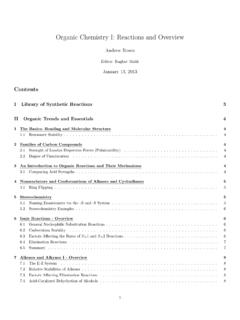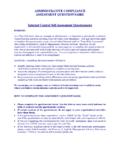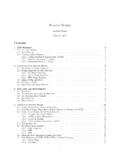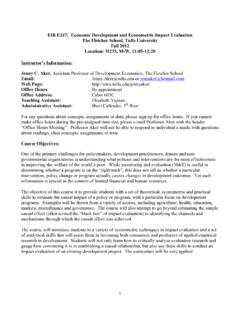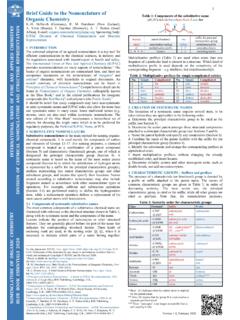Transcription of Organic Chemistry I: Reactions and Overview
1 Organic Chemistry I: Reactions and Overview Andrew Rosen Editor: Raghav Malik January 13, 2013. Contents I Library of Synthetic Reactions 3. II Organic Trends and Essentials 4. 1 The Basics: Bonding and Molecular Structure 4. Resonance Stability .. 4. 2 Families of Carbon Compounds 4. Strength of London Dispersion Forces (Polarizability) .. 4. Degree of Unsaturation .. 4. 3 An introduction to Organic Reactions and Their Mechanisms 4. Comparing Acid Strengths .. 4. 4 nomenclature and Conformations of Alkanes and Cycloalkanes 5.
2 Ring Flipping .. 5. 5 Stereochemistry 5. Naming Enantiomers via the -R and -S System .. 5. Stereochemistry Examples .. 6. 6 Ionic Reactions - Overview 6. General Nucleophilic Substitution Reactions .. 6. Carbocation Stability .. 6. Factors A ecting the Rates of SN 1 and SN 2 Reactions .. 6. Elimination Reactions .. 7. Summary .. 7. 7 Alkenes and Alkynes I - Overview 8. The E-Z System .. 8. Relative Stabilities of Alkenes .. 8. Factors A ecting Elimination Reactions .. 8. Acid-Catalyzed Dehydration of Alcohols .. 8. 1. III Reaction Mechanisms 9.
3 8 Ionic Reactions - Mechanisms 9. The SN 2 Reaction .. 9. The SN 1 Reaction .. 10. The E2 Reaction .. 10. The E1 Reaction .. 11. 9 Alkenes and Alkynes I - Mechanisms 11. Acid-Catalyzed Dehydration of Secondary or Tertiary Alcohols: An E1 Reaction .. 11. Acid-Catalyzed Dehydration of Primary Alcohols: An E2 Reaction .. 12. Synthesis of Alkynes from Vic-Dihalides .. 12. Substitution of the Acetylenic Hydrogen Atom of a Terminal Alkyne .. 12. Deprotonation Reagents .. 12. Hydrogenation .. 13. 10 Alkenes and Alkynes II - Mechanisms 13.
4 Addition of H X to an Alkene .. 13. Acid-Catalyzed Hydration of an Alkene .. 13. Mercuration-Demercuration and Hydroboration-Oxidation .. 13. Summary of H X and H OH Additions .. 14. Electrophilic Addition of Bromine and Chlorine to Alkenes .. 14. Halohydrin Formation from an Alkene .. 15. Oxidative Cleavage of Alkenes .. 15. OsO4 Reaction .. 15. Summary for Dihalide, Dihydroxy, and Carbene Additions .. 16. Electrophilic Addition of Bromine and Chlorine to Alkynes .. 16. Addition of Hydrogen Halides to Alkynes .. 16. Oxidative Cleavage of Alkynes.
5 16. 11 Alcohols and Ethers - Mechanisms 16. Alcohols with H X .. 16. Alcohols with PBr3 or SOCl2 .. 17. Leaving Group Derivatives of Alcohols .. 17. Converting OH to LG Summary .. 17. Synthesis of Ethers .. 17. Protecting Groups .. 18. Ether Reactions Summary .. 18. Epoxides .. 18. Epoxide Reaction Summary with Example .. 19. 12 Alcohols from Carbonyl Compounds - Mechanisms 19. Alcohols by Reduction of Carbonyl Compounds .. 19. Oxidation of Alcohols .. 19. Alcohols from Grignard Reagents .. 19. 13 Radical Reactions - Mechanisms 20.
6 Bromination .. 20. Chlorination .. 20. 2. Part I. Library of Synthetic Reactions 1. Note that this is a partial list of Reactions 1 Graphics are obtained mostly from Stony Brook University CHE 327 PowerPoint slides and Organic Chemistry , 10th Edition by Solomons and Fryhle. 3. Part II. Organic Trends and Essentials 1 The Basics: Bonding and Molecular Structure Resonance Stability 1. The more covalent bonds a structure has, the more stable it is 2. Charge separation (formal charges) decreases stability 3. Negative charges on the more electronegative elements and positive charges on the more electropositive elements are more favorable 2.
7 2 Families of Carbon Compounds Strength of London Dispersion Forces (Polarizability). 1. Large atoms are easily polarizable and small atoms are not 2. Atoms with unshared electron pairs are more polarizable than atoms with only bonding pairs 3. Molecules that are longer and atter ( long chains ) have more surface area and thus have larger dispersion forces when other factors are similar Degree of Unsaturation A degree of unsaturation is either a bond or a ring structure 2C + 2 + N H X. Formula: where the variables are the number of carbons (C), nitrogens (N), hydrogens (H), and 2.
8 Halogens (X). 3 An introduction to Organic Reactions and Their Mechanisms Comparing Acid Strengths Factors A ecting Acidity (in decreasing signi cance) : ARIO. 3. 1. Atom 2. Resonance Stabilization 3. Induction E ect 4. Orbital (s character). 2 For the purposes of drawing all resonance structures, it is not considered a violation of the octet rule if a second-row element, like carbon, has fewer than an octet. It is less likely but still imperative to draw. 3 This general trend is not always perfectly applicable. However, it is usually a fairly good indicator.
9 4. ARIO Explained: Atom: Look at what atom the charge is on for the conjugate base. For atoms in the same row, we consider electronegativity. The further to the right on the periodic table an atom is, the more electronegative it is. If a conjugate base's negative charge is on a more electronegative atom, it is more stable, and thus the parent acid is stronger. For atoms in the same column, we consider an atom's ability to stabilize a charge. The further down on the periodic table an atom is, the better it is at stabilizing a charge.
10 If a conjugate base's negative charge is more stabilized on an atom further down a group, it is a more stable molecule, and thus the parent acid is stronger. Resonance Stabilization: Look at resonance structures. The more distributed the charge of the conjugate base is, the stronger the parent acid is. Inductive E ect: Look for inductive e ect. If there are many electronegative atoms near the conjugate base's negative charge, electron density is pulled toward these atoms. This creates more stable anions and thus more acidic parent molecules.

